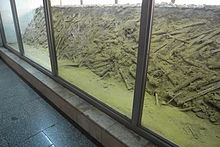
Back عدد قتلى مذبحة نانجنغ Arabic 南京事件の被害者数 Japanese Оценки количества погибших в Нанкинской резне Russian Số người thiệt mạng trong thảm sát Nam Kinh Vietnamese 南京大屠杀的死亡人数 Chinese

| This article is part of the series on the |
| Nanjing Massacre |
|---|
| Japanese war crimes |
| Historiography |
| Films |
| Books |
The total death toll of the Nanjing Massacre is a highly contentious subject in Chinese and Japanese historiography. Following the outbreak of the Second Sino-Japanese War, the Japanese Imperial Army marched from Shanghai to the Chinese capital city of Nanjing (Nanking), and though a large number of Chinese POWs and civilians were slaughtered by the Japanese following their entrance into Nanjing on December 13, 1937, the precise number remains unknown. Since the late-1960s when the first academic works on the Nanjing Massacre were produced, estimating the approximate death toll of the massacre has been a major topic of scholarly debate.
Currently, the most reliable and widely agreed upon figures place the massacre victims within Nanjing City Walls to be around 40,000, mostly massacred in the first five days from December 13, 1937; while the total victims massacred as of the end of March 1938 in both Nanjing and its surrounding six rural counties far exceed 100,000 but fall short of 200,000.[1] Hence, depending on the timeframe and the geographic scope, an empirically verifiable, scholarly valid victimization range is from over 40,000 to under 200,000.[1]
The center of the debate rests on the validity of burial records and oral history. A lesser debate rests on who among the dead should be included as "massacre victims". Numbers smaller or larger than the empirically verifiable, scholarly valid victimization range have been put forward by Japanese revisionists and the China Communist Party. Some of the lowest estimates have counted only 10,000 deaths,[2] while the government of China maintains that approximately 300,000 people were killed.